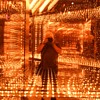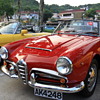Posted 11 years ago
 rniederman
rniederman
(346 items)
January 7, 2014 is just around the corner. So ... why is this date so special? For camera collectors and historians it marks the 175th anniversary of the announcement of daguerreotype photography in 1839; the first commercially available process to the public. And the world instantly changed!
Whether you know it or not, all picture taking methods up through today’s digital photography are based on a simple concept of creating a permanent image using a lens placed at one end of a dark chamber. Yep, that means every black and white image, those boring Kodachrome vacation slides, Facebook and Instagram pictures and so forth (including movies and selfies) share the same basic DNA as the first photographic discoveries.
Shown here is a block of 15 cent stamps (probably around 1978 or so) issued by the United States Postal Service celebrating photography. Several ‘tools of the trade’ are depicted. Also shown on this post is the oldest camera in my collection; an 1854 Palmer & Longking made exclusively for the daguerreotype process.
I’ve been deeply involved with photography since the 1960s and have handled a lot of imaging technology and cool cameras. I studied with Ansel Adams in one of his famous Yosemite workshops with a large format 4x5 field camera (polaroid backs and sheet film). And then I openly embraced digital photography and love it. Yet I cannot imagine what the next wave of imaging technology will be. But I am definitely looking forward to it!

















Great camera and stamps!!
Thanks, Sean!
Your very welcome Rob!!!
Love it Rob :) - Stamp is Scott catalog# 1758 designed by Ben Somoroff and issued on June 26th, 1978 (Photogravure)
Thanks, vetraio50!
Thanks, aghcollect and great info.
Thanks, David!
Thanks, valentino97!
Thanks, tom61375!
Thanks, Eric!
Thanks, Leah. The colored objects are filters for B&W photography. They are used when taking a picture and change the contrast of B&W negatives, which affects printing. For example, red is the deepest filtration for increasing contrast. When used for shooting landscapes, blue skies will render nearly black, foliage will darken, etc. Red and orange hued objects (such as apples) will brighten to nearly white. A yellow filter is similar but doesn't increase contrast so dramatically. It is also a favorite for landscape work with partly cloudy skies because it will separate white cloud hues from the background sky when a print is made.
Thanks, geo26e!
Thanks, f64imager!
Thanks, Leah!
Thanks, petey!
Thanks, bratjdd!
Thanks, Lisa!